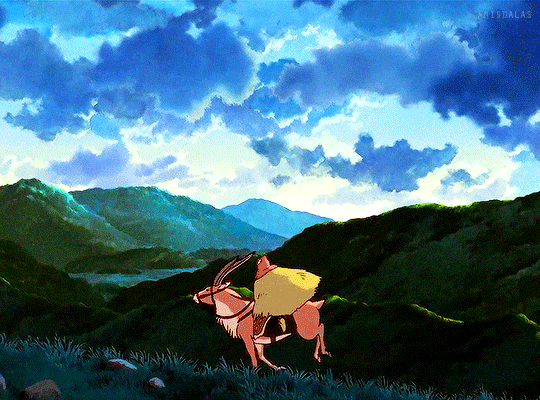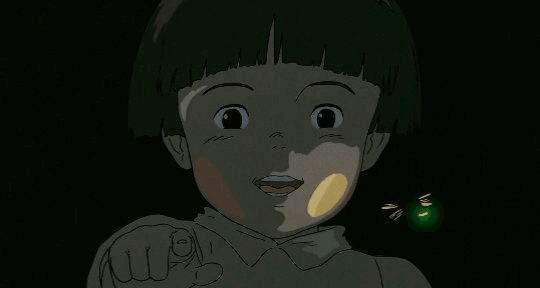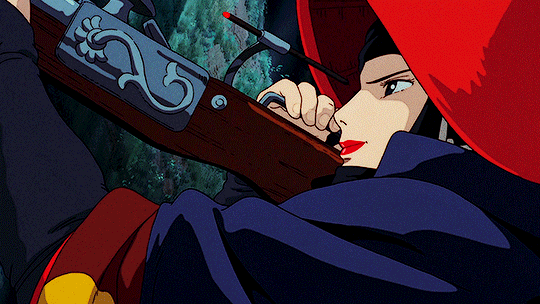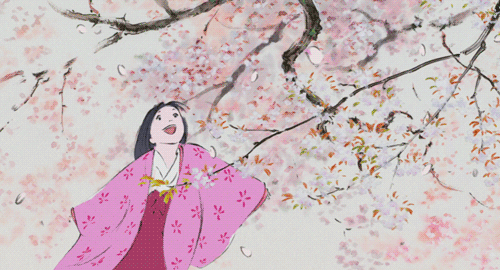originally posted at https://canmom.tumblr.com/post/680906...
My friends, my friends…
…this is it! Three digits! No gaps! ADHD girl really stabilised the reactor core!
We’ll save the full recap of the last year of Animation Nights for 104, but I do have one big announcement to make: the Animation Night Archive is now available on canmom.art!
There’s still a great deal to be done to make it ‘better than tumblr’, like fixing alt text and correcting links to stay on the site, wiring up the commenting system, and fleshing out some of the writeups. But if you’d like to read 100 passionate articles on animated films of all sorts from a pretty big cross-section of time, it’s already all there for your perusal <3

Tonight, I think the best way to celebrate is to finally show Princess Mononoke (Mononoke-hime for ye weebs who think we’re all cool writing things in romaji, もののけ姫 for people who actually read Japanese :p). It’s no secret I love this film, most of all Miyazaki’s works, and I’ve put it off for the sake of finding less familiar things. Well, time to give Miyazaki his due! We covered his and Takahata’s early career back on Animation Night 70, but what of his works as the infamously strict master of Studio Ghibli?
Princess Mononoke came at what I see as a very bleak turning point in Miyazaki’s ideological development; he had made his break with Marxism and was struggling to see a future beyond ecological collapse, and it is precisely this struggle that led to the 90s producing some of his most powerful works such as the later parts of the Nausicaa manga.
The film takes a jidaigeki (Animation Night 24) setting and uses it to tell a kind of ambivalent parable. Let’s begin with the big picture: we see Lady Eboshi, a noblewoman in the Muromachi period (during which firearms were becoming established, and Japan would splinter into feuding microstates), seeking to provide a haven for lepers and sex workers cast out of Japanese society, found an extractivist project mining iron from the edge of a great forest. This iron, used to create guns, equips her people with the military strength to fend off the samurai, and for all that they labour smelting iron and putting together guns, the people of Irontown are glad to have been given a place of belonging. But it also comes at the expense of the animal spirits of the forest, organised into their own factions - boars, apes, wolves - who attempt to fight off the destructive incursion onto their lands, even though it means a futile death.

In the midst of all this, seemingly aloof from the conflict, is the mysterious Deer God (シシ神, which JP wiki suggests to be based on the giant yōkai Daidarobotchi), a deific figure with bestows and takes life and, at night, transforms into an emormous creature resembling the night sky. Eboshi strikes a deal with the Emperor (at this point in history a figure of very reduced power) to kill and take the head of the Deer God, which is said to bestow immortality.
All this would absolute end in disaster if not for Ashitaka and San. Ashitaka is a prince of the Emishi people, an ethnic group gradually conquered and genocided by the Yamato people in the 8th and 9th centuries. Miyazaki imagines that a small village of Emishi survived into the Muromachi period. Ashitaka is a beloved figure in this village, young and pretty (at a later point he’s called an いい男 which can be translated as ‘twink’!) and good at shooting arrows. But a demonic boar attacks the village, created by the festering wound of one of Eboshi’s bullets in the body of a despairing boar god Nago, and though Ashitaka defeats the boar, he is cursed by a black stain that spreads across his arm. Remorsefully, the village elder commands him to abandon his people and go West to the origin of the bullet to see if he can lift the curse, and to ‘see with eyes unclouded by hate’.

Ashitaka takes this mission deeply to heart, and travels to Irontown, intervening in the conflict with the supernatural strength granted by his curse. He first visits Irontown and becomes acquainted with their situation, but when a human girl attacks the village - San, known to Irontown as the ‘Princess Mononoke’, essentially princess of evil spirits - and when she is defeated by Eboshi, Ashitaka intervenes to carry her away. San is not especially happy about all this, viewing herself as an enemy of the humans, but Ashitaka manages to convince her not to kill him, and as he passes out, she takes him to the Deer God to either kill or resurrect him. Afterwards, he ends up spending a stint with the wolf goddess Moro who is San’s adopted parent, and sees the proud boars marshalling for war. The wolves, San included, know it’s futile, but go to join them anyway, and Ashitaka is powerless to intervene.
Supported by the Emperor’s forces, Eboshi slaughters the animals, and sets out to kill the Deer God. The samurai launch another attack on Irontown, and Ashitaka desperately runs about trying to stop everyone killing each other. When Eboshi kills the Deer God - inspired, apparently, by the novel Gilgamesh by Takeshi Umehara - a catastrophe ensues as the God turns into a huge flood of slime engulfing the land. Ashitaka realises that human hands must return the head to end the catastrophe, and he and San chase after Eboshi and the imperial soldiers attempting to flee with the head. In the end, Ashitaka and San raise the head - San taking on the role of a human - and the crisis is averted, with flowers blooming across the wreckage. The people of Irontown swear to live in a different way and Ashitaka goes to join them, but the film ends on an ambiguous note, for the driving forces remain unresolved…

So how did this movie come to be? Where last we left their story, Miyazaki and Takahata had made their way up, leaving their early days in the Toei union far behind to work at various TMS related studios, and transformed the tiny studio Topcraft into a gathering of star ‘charisma animators’ who collaborated on Nausicaa of the Valley of the Wind in 1983-4. This was essentially the origin of Studio Ghibli: off the back of that film, the studio was founded in 1985 as a subsidiary of Tokuta Shoten. We watched their first film as a studio proper, Castle in the Sky, back then. Miyazaki continued to write Nausicaa throughout this period, well into the 90s.
Let’s quickly go over the Studio Ghibli films of the 80s and 90s. I’ll cover all of these films in much more detail in Animation Nights to come, mind you.

In 1988, they hit everyone with what may be the most whiplash-inducing one-two punches in the history of animation: Miyazaki directed an incredibly sweet film My Neighbour Totoro (となりのトトロ) about childhood in rural Japan, with an undercurrent of the impending loss of a parent kept understated enough to add dimension to the playfulness without destroying it, the designs taking after his earlier work Panda! Go Panda!… while Takahata directed his most famous film, Grave of the Fireflies (火垂るの墓) about children starving to death in wartorn Kobe, marked by an almost painfully beautiful realism in how it portrays, in particular, light and shadow. These films were released back to back, and each one was a powerful statement of the respective director’s concerns… but can you imagine watching them side by side? Well soon enough you won’t have to because I intend to replicate that one-two punch in a few weeks. You’re welcome :p
The next year, Miyazaki directed Kiki’s Delivery Service, adapting a children’s book, in which a young witch strikes out on her own and struggles with depression; it feels like a very personal film and true to the struggles of an artist. Then in 1991, Takahata directed Only Yesterday (おもひでぽろぽろ), which broke from most of the rules of animated films by being a down to earth, realistic drama about the nostalgia of a Tokyo woman travelling out to the countryside; another major hit, I imagine it did a lot to open the door for the serious turn of anime film in the 90s, such as the work of Mamoru Oshii.

1992 saw Porco Rosso (紅の豚), a wistful film about a Mediterranean aeroplane pilot who has been cursed to be an anthro pig; Miyazaki faces up to the contradiction of his love of aeroplanes and their reality as a tool of war. It contains the memorable line ‘better a pig than a fascist’. The pilot encounters a young girl engineering prodigy who insistently gets involved in his life, and fights his rival the sky pirate, but mostly it’s about setting a mood of a lost age of aviation; it’s the first time we see the image of the aeroplane graveyard in the sky.
1993 had the first film of the studio not directed by either Miyazaki or Takahata, with Ocean Waves (海がきこえる, lit. I Can Hear the Sea) directed by Tomomi Mochizuki, who had previously mostly worked on magical girl series. Taking after Takahata’s Only Yesterday, it also sees a pair of reunited characters reminiscing on their childhood. Although controlled by Ghibli, most of the animation for this film was actually made at other studios such as Madhouse, JC Staff and Oh Pro.
1994 had Pom Poko, the sad story of tanuki fighting to prevent their homes being destroyed by housing development, despite their efforts to conjure a parade of yōkai and otherwise scare away the humans. As gorgeous film as you’d imagine, shifting confidently between levels of stylisation, we watched it back on Animation Night 41.

1995 saw Whisper of the Heart directed by Yoshifumi Kondō, in which a girl is transported by an anthropomorphic cat into a fantastical world. Kondō had worked with Miyazaki and Takahata in the early days on Panda! Go Panda! and Future Boy Conan, and joined Ghibli in the late eighties, mostly working as a key animator and animation director. They had high hopes for Kondō, who was set to become the studio’s third main director, but tragically he died of a heart aneurysm in 1998 leaving Whisper of the Heart his only film.
And that takes us up to tonight’s film. Although Miyazaki’s later films tend to have a higher profile, I think the late 80s and early 90s are one of the most interesting periods of the studio, since they were still in the process of defining what this ‘Studio Ghibli’ would be. As we talked about last time, Miyazaki was a union man and a Marxist in his youth.
There’s always a curious contradiction here, because he participated (as the single layout artist for every single shot!) in the brutally high pressure production environment of Takahata’s Heidi: Girl of the Alps. This ethos of demanding a lot from his workers in pursuit of quality never really went away since, from either director, but especially with Takahata.

Miyazaki’s obsessive attitude to work begins with himself of course - he is known for strictly correcting every single drawing in his films, instead of leaving it up to the key animators and animation directors as in most productions, a tendency which became stronger and stronger after Nausicaa. But he expects the same from his studio. Ghibli may offer a much better deal to animators than the industry at large, with salaried positions and better pay, but when animators have left Ghibli, such as Colorido’s Yojiro Arai (Animation Night 72), it is typically over the intense workload. Takahata is especially demanding, and has said to have destroyed many careers, and has even been blamed for the death of Yoshifumi Kondō mentioned above:
Suzuki visited Kondō in Sendai after he had finished work on Whisper of the Heart. They had a two-hour conversation where Kondō told Suzuki that Takahata had “tried to kill him” and that even thinking about Takahata would cause Kondō to tremble.
Kondō fell ill at the age of 47 and died in 1998, after his work on Princess Mononoke. Suzuki, Miyazaki, Takahata, and another animator that Suzuki refers to as “S-san” all attended his cremation. S-san had worked with Takahata and Miyazaki since their time at Toei Animation. During the cremation, Suzuki says that S-san said aloud, “It was Paku-san [Takahata] that killed Kon-chan [Kondō], wasn’t it?” The air in the room froze until Takahata quietly nodded.
According to Suzuki, Miyazaki has claimed that he’s the only person to survive Takahata. The studio continued to lose potential artistic successors due to Takahata’s work expectations.
How these men reconciled their Marxist beliefs with such an interpersonal ethic, I cannot say. Regardless, the 90s were also a time of, as alluded above, a big crisis for Miyazaki’s own belief system. In 1994, he said outright that ‘Marxism was a mistake’ (see this very long video by Zeria for immense detail on Miyazaki’s evolving politics), and the ecological themes - already pretty strong as far as Future Boy Conan - became increasingly central to his work as he became increasingly disgusted with both Japan and the world at large.

In this respect, the arc of the Nausicaa manga is an especially strong window. I have the book Starting Point, a collection of interviews with Miyazaki from across his early career, and the one I’m going to focus on starts on page 390, in 1994 shortly after the Nausicaa manga ended. Miyazaki says that he never planned out the full arc of Nausicaa, and went through many struggles to continue it, and you can certainly see this in the evolution of the story and gradually evolving complexity.
To put it mildly, Nausicaa is bleak. Not just the post-apocalyptic setting, but the wars and cruelty within its pages. Nausicaa becomes a kind of messianic peace figure in her world, but her own discoveries only make the picture bleaker. Over the course of her travels she learns that that her and all the people of her age are too corrupted to even be able to survive in the new world being created by the vast terraforming system of the Sea of Decay, and that the architects of the system live in a vast vault waiting for the world to be cleansed, attempting to persuade her to protect the system. Meanwhile, she becomes a kind of mother figure to a resurrected ‘God Warrior’ (kyoshinhei), who in her confusion she shapes into an ‘arbiter’ casting judgement.
Miyazaki writes that he felt out of his depth with the philosphical and religious themes he ended up falling into; here are a few quotes I find interesting:
Bonnō, or wordly desires, may emerge in our minds as a scrambled mess, but if we want to transcend them and arrive at a true purer state of being, then I have this terrifying sense of foreboding that we might wind up as plain old pebbles or drops of water.
And,
Ultimately, the question is whether the young heroine, Nausicaa, who has the weight of the world on her shoulders, can ever truly return to a normal life. Can she really go on living without losing her mind? The only thing I know is that she probably will never be able to go back to being the way she was, but that she can definitely continue as she has become, that she can become a witness to what has happened.
In the end, confronted with the ‘pure’ people who intend to take the corrupted world, Nausicaa elects to slaughter them and commit to her own doomed people - the life that actually exists, however flawed and impure. It’s a fascinating ending, deeply ambiguous but resonant and provocative.

As Miyazaki was writing Nausicaa, the Soviet Union collapsed, just as the Dorok empire collapsed in the story. In Starting Point, Miyazaki relates his horror at the war in Yugoslavia, and his feeling that his old way of thinking about nations and historical forces was inadequate. Let me quote what he had to say in full, rather than present my spin on it:
As I was trying to complete Nausicaa, I experienced a change in my thinking that some people might regard as a political sell-out. It’s because I clearly abandoned Marxism. You might say I had to abandon it, but it wasn’t easy to decide that Marxism was a mistake, that Marxist materialism was all wrong, that I had to look at the world in a different way. I still occasionally think it would have been easier for me to continue thinking as I had been.
I didn’t experience any dramatic, fierce internal struggle before changing my way of thinking; I was simply no longer able to deal with the various doubts that had been accumulating as I wrote. And I don’t think I abandoned Marxism because of any change in my position within society - on the contrary, I feel that it came from having written Nausicaa.
For example, I felt a little hesitation in the beginning simply because I had made Nausicaa the daughter of Jihl, the king of a small nation, which therefore made her a princess. Anticipating that some people might criticize my heroine for belonging to an elite class, I armed myself wit hall sorts of theories to defend myself. But after a while I no longer cared about that. Nausicaa could have been born anywhere. I have no intention of arguing about it at all. No matter what class people are born into, idiots are still idiots and good people are still good. It’s not just about right or wrong in this world; people are either good or not, people we want to have as friends or not. I’ve resolved not to think of things in terms of class consciousness. The idea that someone’s right just because he’s a worker is a lie. The masses are capable of doing an infinite number of stupid things. And I certainly don’t trust public opinion polls.
So with all this, we simply wind up back at a very ordinary place. I’m not talking about something as profound as having had the scales fall from my eyes, but if I think of my new state of mind as returning to believing just what I’ve been told over and over again, then it does seem depressing. However, it is something I have to accept. I have simply resolved to take responsibility for the way I saw the world.
Thus Miyazaki’s new worldview would be perhaps more simple and moralistic, but also driven more by his own judgement than received wisdom. He describes how he should have trusted his first, negative impression of Mao, and how he supports something called the Totoro Forest Project and lets them use his characters not because they are ‘right’ but because in his view, they are good people, ‘really doing good, steady work’ for their love of Sayama Hills, (rather than being ‘ecology fascists’!) - perhaps a surprising thing to read given that if anything, his next film stands as a film which seems to reject the idea that there are simple good and bad people, with complex misguided figures like Lady Eboshi.
It certainly sounds like Miyazaki’s old Marxism was pretty crude, but I can’t say I fully follow the thread of where he walked. It’s striking to me how much the sentiments here contrast with what I see as valuable in his works of this period. But in any case, let’s go back to the films. Sadly, Starting Point stops just before Princess Mononoke, so I can’t provide any directly relevant Miyazaki quotes. But we can certainly read between the lines a bit.
When Miyazaki finished the Nausicaa manga, the problems he was wrestling with were by no means resolved. During this period, Nausicaa was his serious work so he was able to treat lighter topics in the films, but as Nausicaa ended, ‘no weight had lifted from his shoulders’, and his ‘second most difficult work’ stepped up as the new problem. That work I can only guess was the still-in-production Princess Mononoke.

This film was, in all ways, ambitious. Compared to a typical drawing count of 50,000-70,000, Princess Mononoke used over 140,000; if I can trust the machine translation of Wikipedia, Miyazaki said he intended to ‘use up’ Ghibli, but instead ended up expanding their production process so that their later films would also hit similar numbers. They introduced new CGI compositing effects to generally good effect, blending well with the traditional animation. But of course it was the traditional animation itself that really shines.
The technical level of this animation is something else: the physical understanding of the movement of hair and cloth and other secondary action, the excellent balance of clear shapes and detail in the drawings, the subtle expressiveness of the motion without overexaggeration, the beautiful colour choices of Ghibli’s brilliant colour designer Michiyo Yasuda (who sadly died in 2016), and (of course!) Joe Hisaishi delivering a suitably grand soundtrack that conveys the awe of its setting. The film’s approach to violence is also notable: always abrupt and shocking, rarely extended battles, and really quite gory with Ashitaka shooting off arms and heads (such as in this memorable sequence by Toshio Kawaguchi).
It is a supremely confident film visually, as always with Ghibli delivering memorable character designs, in this case the work of Masashi Ando and Yoshifumi Kondō, who also served as the film’s chief animation director. (Ando is a brilliant realist animator who worked on many of Satoshi Kon’s films, Eva 3.0, and Dennō Coil among other things; he will shortly be debuting his first film as director with Production I.G.’s Shika no Ō which played at Annecy last year, but so far doesn’t seem to have seen wider release. I can’t wait.) Ghibli gets to take their pick of key animators, and they deliver some truly great work. And the background artists absolutely kill it, with a perfect sense of the appropriate level of detail and use of texture in their paintings. Ghibli went through the digital transition better than many, but all the same Princess Mononoke’s physically painted cels are just delicious. Here, a large collection of production materials, including settei, genga, concept art watercolours and finished cels.

I believe one of the strongest paths to good art is to directly confront the questions which most trouble a person, which will depend on the artist. For Miyazaki, it is this question of environmentalism and the possibility of society breaking from its cycle of conflict - in that Nausicaa interview, he describes his fascination with war as being akin to an AIDS doctor’s study of the disease. It seems like the last time that Miyazaki ever confronted these questions in a serious way, and I don’t think he was able to answer them in a concrete way, but he was at least able to pose them very well, without reaching for easy answers or simple moral condemnation.
There’s no question that Eboshi’s colonial extractivist project is deeply harmful and unsustainable; nor are her grand (and, in my reading, sincere) ambitions of ‘saving’ the lepers and sex workers she recruited able to overcome the stigmas of the dominant society. And yet, while far too many environmentalist films don’t ever bother to ask ‘why’ the film does not write these characters off as simple villains; we can all too clearly see why Eboshi would choose this route, and why people would readily follow her, in the fraught world where she lives, to the comfortable bubble of Irontown with its broken gender roles and safety from the samurai. Irontown answers a genuine need for social transformation, but on a reprehensible basis.

And to make it a full themed night of gorgeous interpretations of Japanese mythology, we’ll be seeing Takahata’s The Tale of Princess Kaguya (かぐや姫の物語) [2013]. This came right at the end of Takahata’s career, and I won’t cover the intervening period right now - we’ll come to it on later Animation Nights though, trust me. It is a one of a kind film, its art taking on a gorgeously expressive simplicity based on sumi-e watercolour painting, also known as ink wash painting. Sound familiar? The great Chinese animator Te Wei also made animation based on ink wash paintings, which we discussed a bit back on Animation Night 27; subsequently it’s received a fantastic historical writeup by Animation Obsessive which describes the absurdly elaborate methods they used to create the gradients of ink wash painting, such as layering dozens of translucent cels.
Takhata’s approach is different from Te Wei’s; he uses the usual flat colours of cel animation, and rather it is the lineart style, with its loose graceful curves and varying opacity and weight, and background style full of white negative space, which reflects sumi-e. The film adapts a renowned Japanese legend, The Tale of the Bamboo Cutter (Taketori Monogatari), in which a lunar princess descends to earth and is drawn into the Heian period court. (It’s a bit older than Heike Monogatari (Animation Night 91) if you’re wondering!)
I’m going to leave it at that for now, because it’s already very late, but I’d love to find a chance to write more about Kaguya once we’ve watched the film, so stay tuned.
And, to keep up my credibility, the collection Winter Days of short animated films set to the 17th-century poetry of Bashō featuring the work of many brilliant animators from a variety of countries such as Takahata, Yuri Norstein, and Aleksandr Petrov, last seen like a million years ago on Animation Night 8. (No, we have not done Yuri Norstein yet… but that will be addressed soon enough!) I can’t say much more about that one right now for the same reason, but once I’ve seen the films, I think there will be a lot to pick apart!
Comments